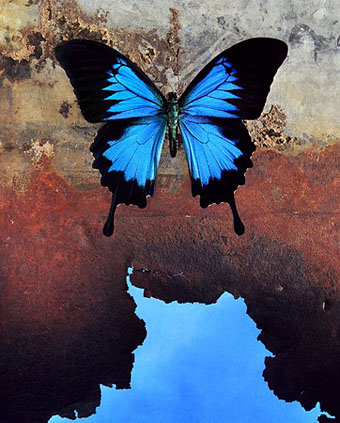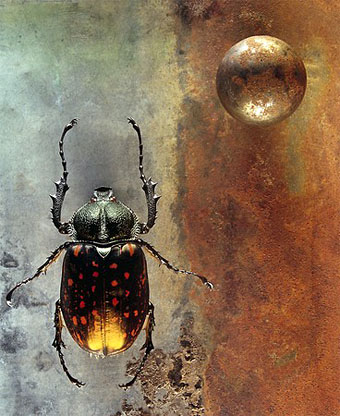Papilio ulysses (2000).
Best. Insect Art. Ever. From a series entitled The Theater of Insects, also the name of a book devoted to Ms Whaley’s photographs which will appear from Chronicle Books later this year.
The photographs in this book are fantastic field illustrations. While the insects in these images are real, the backgrounds are imaginary altered habitats of my devising. Inspired by the old dioramas found in natural history museums, the pinned insects are arranged in constructed environments. The studio where I create the images is as much a theatrical scene shop as it is a photography studio. The prop room looks like an eighteenth-century cabinet of curiosities, in that it is filled with specimens of natural history and visual oddities of manufacture. I use free association and intuition to make decisions about arranging the insect with a particular backdrop. Looking at color, shape, and form, I move the elements about until the magic of the image appears. Lighting the scene is challenging as the sets are only about five by seven inches across with a depth of about an inch and a half. Yet the studio lighting is key to breathing a spirit into these pinned specimens and unifying the disparate elements within the mise-en-scène Finally, the performance of the image is concluded with a single click of the camera’s shutter. (More.)
Coleoptera (2003).
Via Fabulon.
Previously on { feuilleton }
• Endangered insects postage stamps
• Robert Lang’s origami insects
• Lalique’s dragonflies
• Lucien Gaillard
• Wesley Fleming’s glass insects
• Insect Lab



VERY neat. Not to mention cool.
Very beautiful indeed; thank you.
May I in return mention another lovely book of moth photographs, Joseph Scheer’s “Night Visions; The Secret Designs of Moths”? Gorgeous high-res images of moth wings (and a title that rather suggests the moths are Up To Something). It came out a few years ago, I think, but Amazon still stock it.
That book looks great–our moths here are rarely that attractive–and makes me think in turn of Stan Brakhage’s abstract film, Mothlight, which was created by gluing the wings of moths to a strip of film. YouTube has a copy (and yes, the lack of soundtrack is intentional).